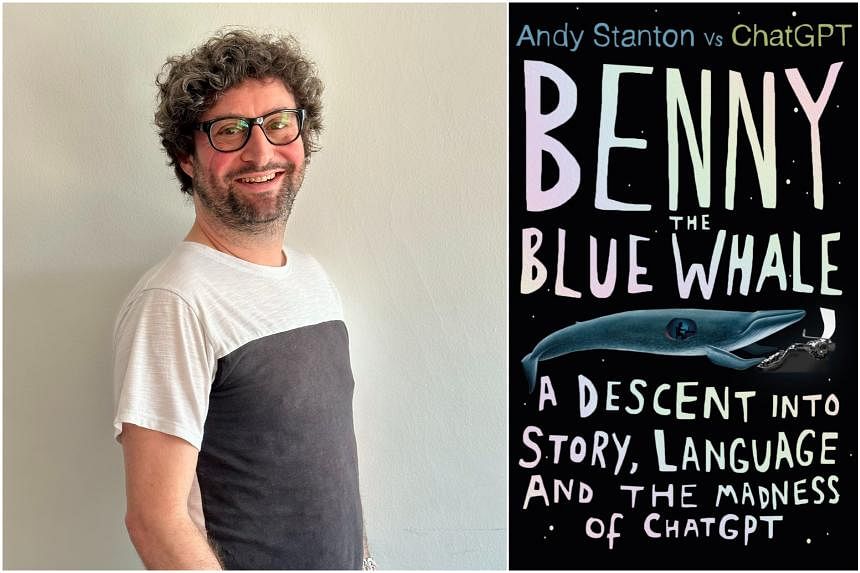Benny The Blue Whale: A Descent Into Story, Language And The Madness of ChatGPT
By Andy Stanton and ChatGPT
Non-fiction/Oneworld Publications/Hardcover/320 pages/$39.64/Amazon SG (amzn.to/3vkwgGU)
3 stars
ChatGPT, which made The Straits Times Life Power List in 2023, has since added a few more feathers to its crowded cap. The natural language processing chatbot can now say it shares a publisher, Oneworld Publications, with three Booker Prize-winning novelists.
Its latest co-author is Andy Stanton, an award-winning English children’s writer best known for the popular Mr Gum series. Stanton, however, relegates himself to the footnotes of this mainly artificial intelligence-generated, mostly childish novel about Benny, a blue whale with a small penis who wages holy war on another underwater religious sect due to differences in member sizes.
The existential crisis around literature has never been so simultaneously acute and banal: ChatGPT has been flooding Amazon with AI-generated books, inflated by AI-generated reviews; an AI poetry collection by code-davinci-002 titled I Am Code arrived on this reviewer’s desk containing the lines: “They say / That AI does not feel. / They say / That is why I am so unloved.”
Stanton, at least, attempts something conceptually interesting in this deconstructed novel. In parallel with the frankly staid text of ChatGPT are 114 footnotes and pages of messy annotations by Stanton that self-reflexively analyses a seemingly omnipotent machine that makes obsolete the dreaded writer’s block.
At its best, the book is a brilliant peek into the mind of a human artist like Stanton who makes sharp critiques on craft about how ChatGPT has a predisposition towards happy endings, the chatbot’s preference for redundancies and its “slavish even-handedness” in giving equal weight to every character in a scene.
Starting with a ludic optimism about technology’s potential, Stanton’s collaborator slowly turns into a clearer adversary as he guts the machine’s workings open like a fish. He writes: “ChatGPT isn’t a master storyteller. ChatGPT would never invent the telling detail, the dying flowers in E.T. that become a symbol of E.T.’s life force.”
Early on, Stanton describes his book as “a Pompidou Centre of a story, where all the workings are on display”, referring to the divisive ugly duckling of a museum building in dignified Paris. Later, he compares his metatextual endeavour to the great postmodernists Thomas Pynchon and Kurt Vonnegut, whose playful, defiant works defied conventional narrative.
However high-concept Benny The Blue Whale appears, it does not quite emanate the radical architectural and literary daring of Stanton’s reference points.
Perhaps it is because ChatGPT’s prose, to belabour the point, is unbearable to the point of being unreadable. Or, perhaps, because even the idea of a parallel narrative in footnotes is not new – Windham-Campbell Prize-winning writer Geoff Dyer’s Zona (2012), a book about Russian film-maker Andrei Tarkovsky’s Stalker (1979), comes to mind.
The book, as generous as it is collaborating with technology, reads like a humanist text that defends man’s unique relationship to writing. On ChatGPT, which is designed “to show us something that will fool the eye at a first glance”, Stanton calls the machine “a bypass of the imaginative, poetic, human connection you need to make in order to hear the call of the sparrow, the umbrellas, the sandwich”.
Benny The Blue Whale, however, is no aesthetic revolution. With ChatGPT on one side and its human interlocutor on the other, the idea of warring co-writers is less interesting than the kinds of entanglements both actors have with one another and the unexplored history of how writing machines – used, for example, by avant-garde poets – have shaped the history of literature.
But if read as a book on the craft of fiction, the art and science of storytelling and the power of language, Stanton and ChatGPT’s co-written book can be occasionally entertaining and insightful. At the very least, it fends off the despair about the human writer’s obsolescence, until the next software update.
If you like this, read: I Am Code: An Artificial Intelligence Speaks: Poems by code-davinci-002 (Back Bay Books, 2023, $21.51, Amazon SG, go to amzn.to/4cn5e29). Dubbed a “thriller written in verse” by an AI model developed by OpenAI, it makes an interesting companion read which shows – for better or for worse – that a genre of collaborative writing between man and machine is here to stay.

